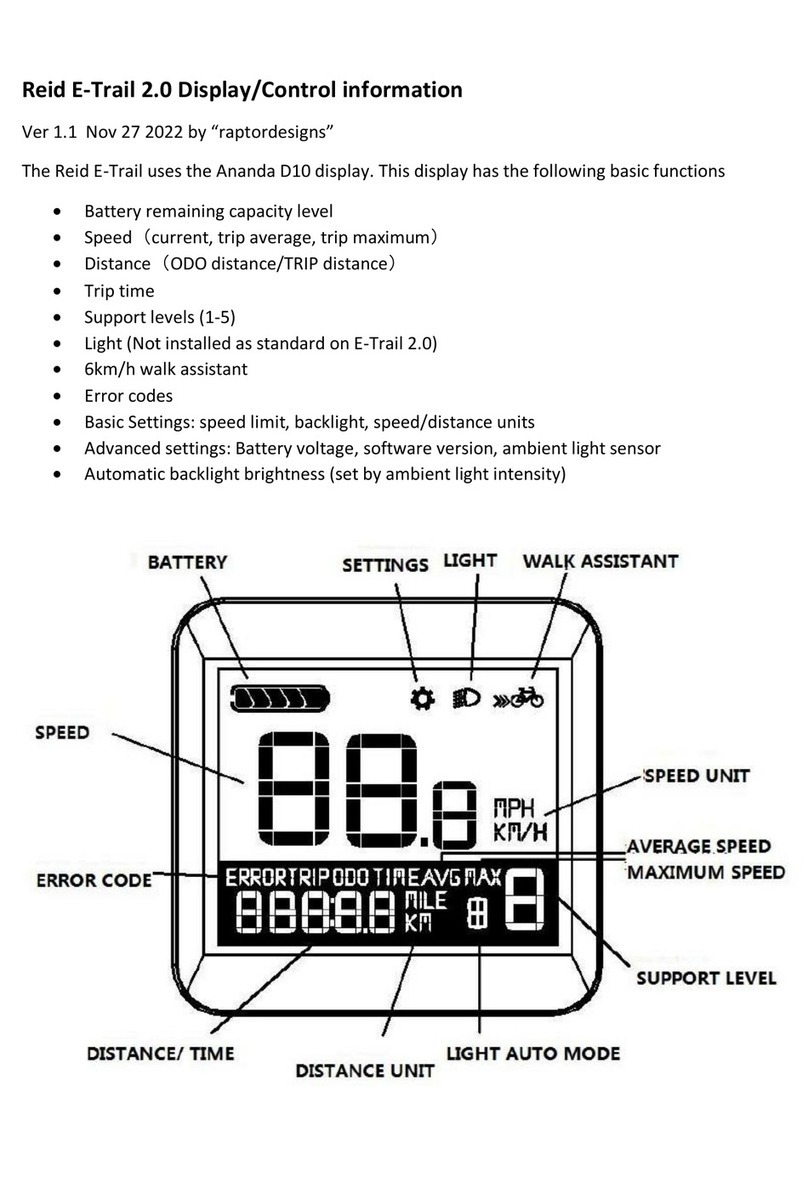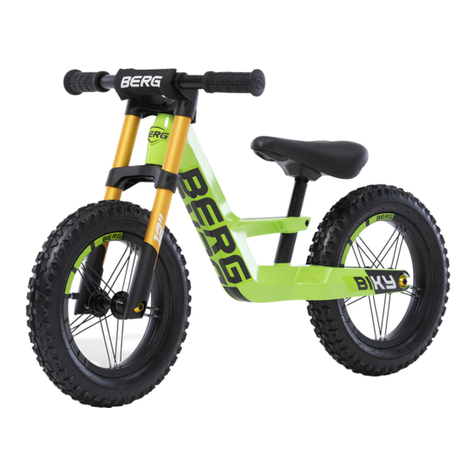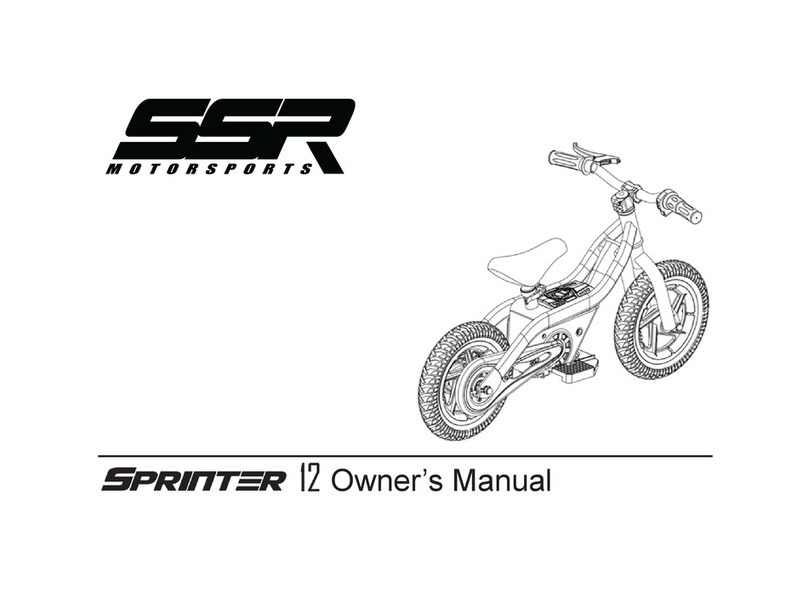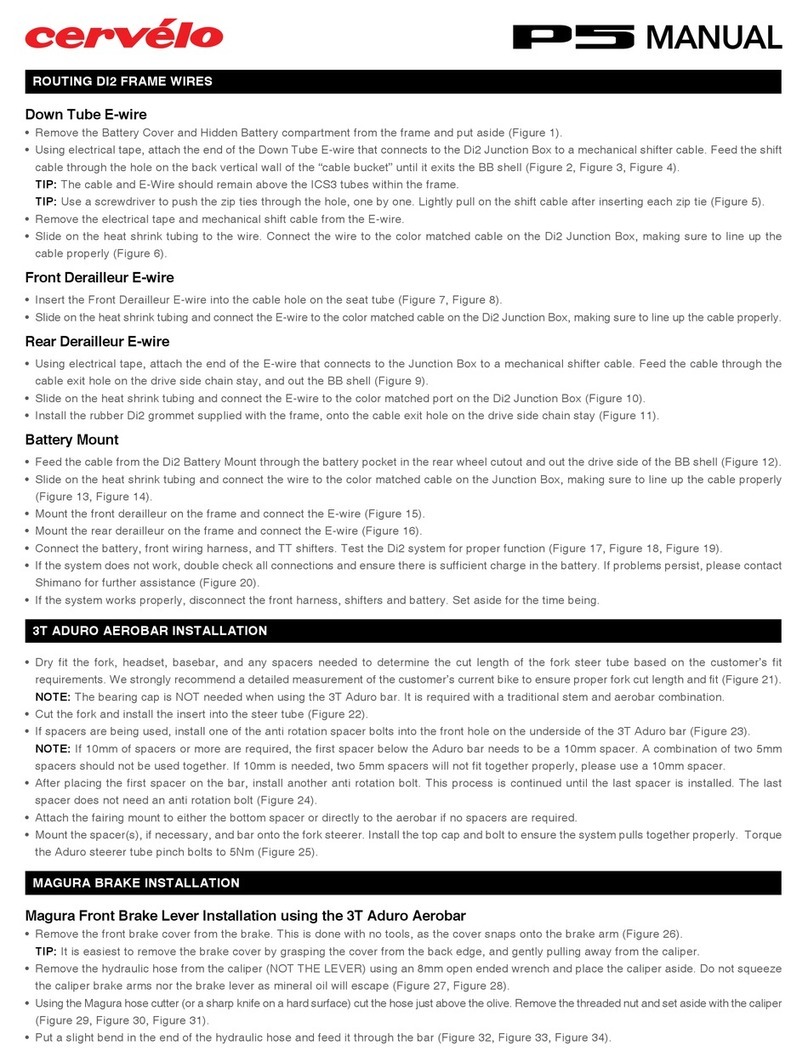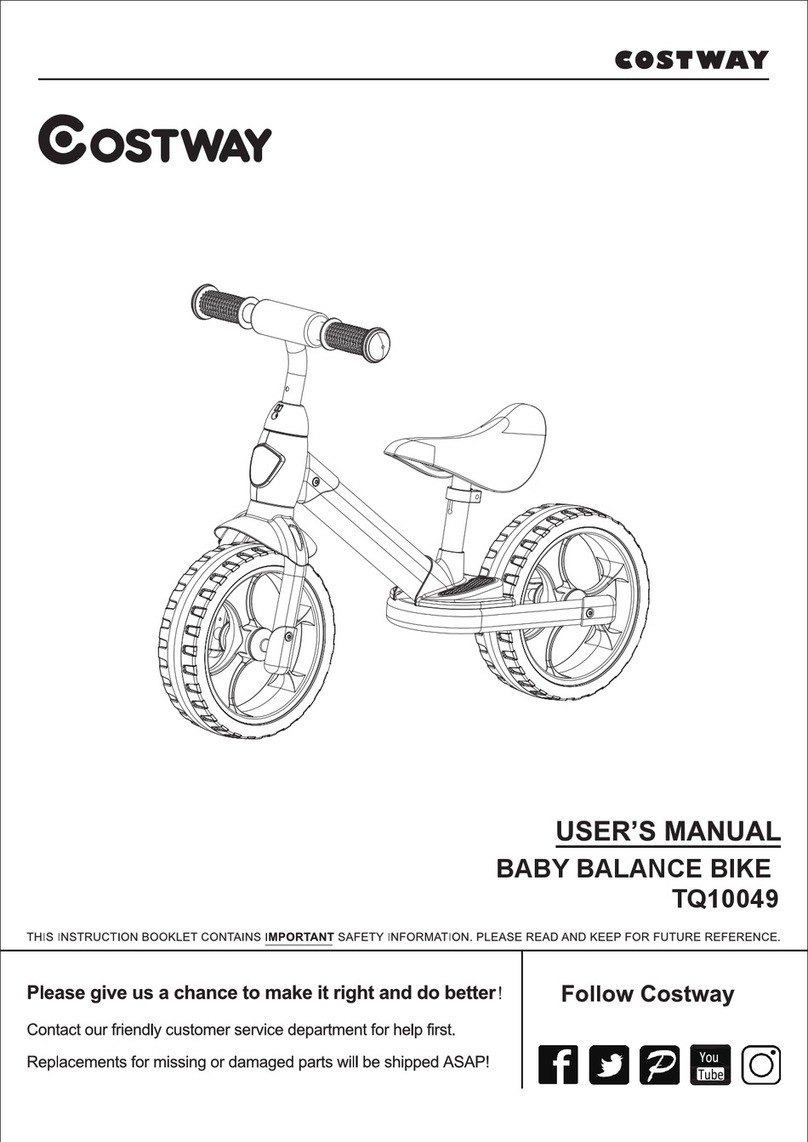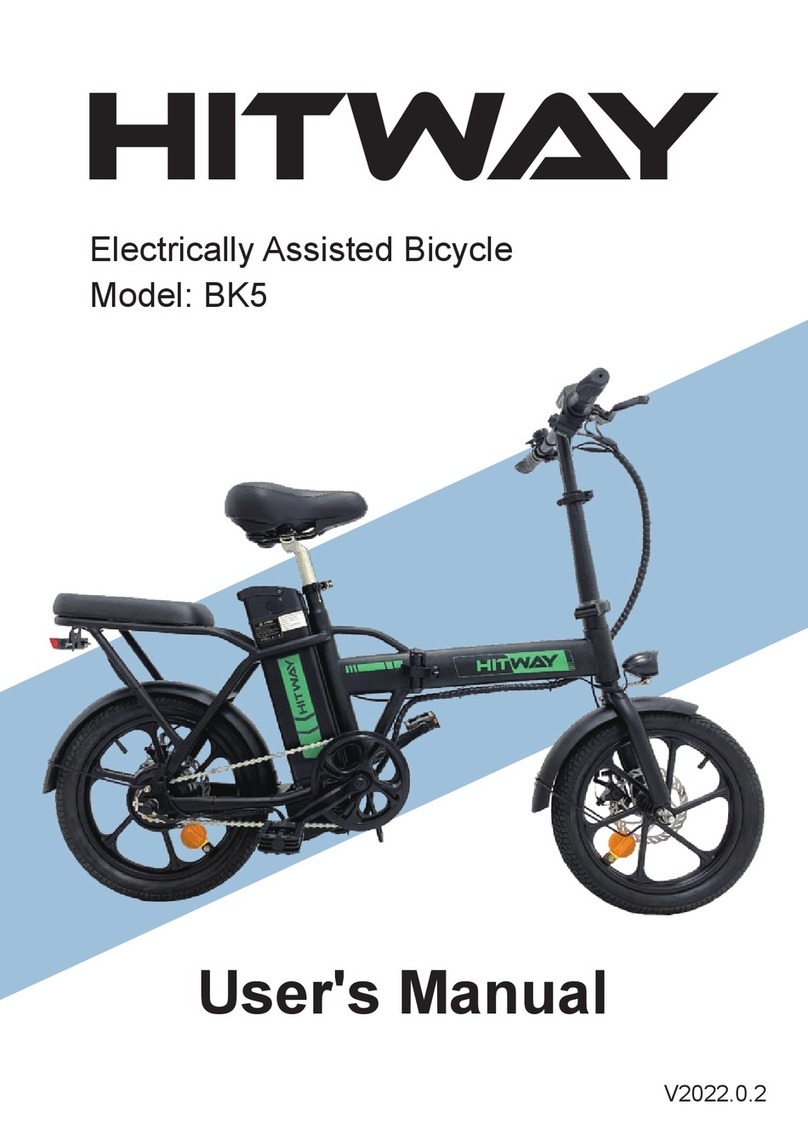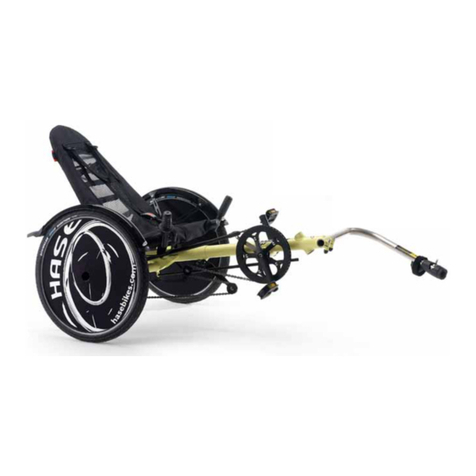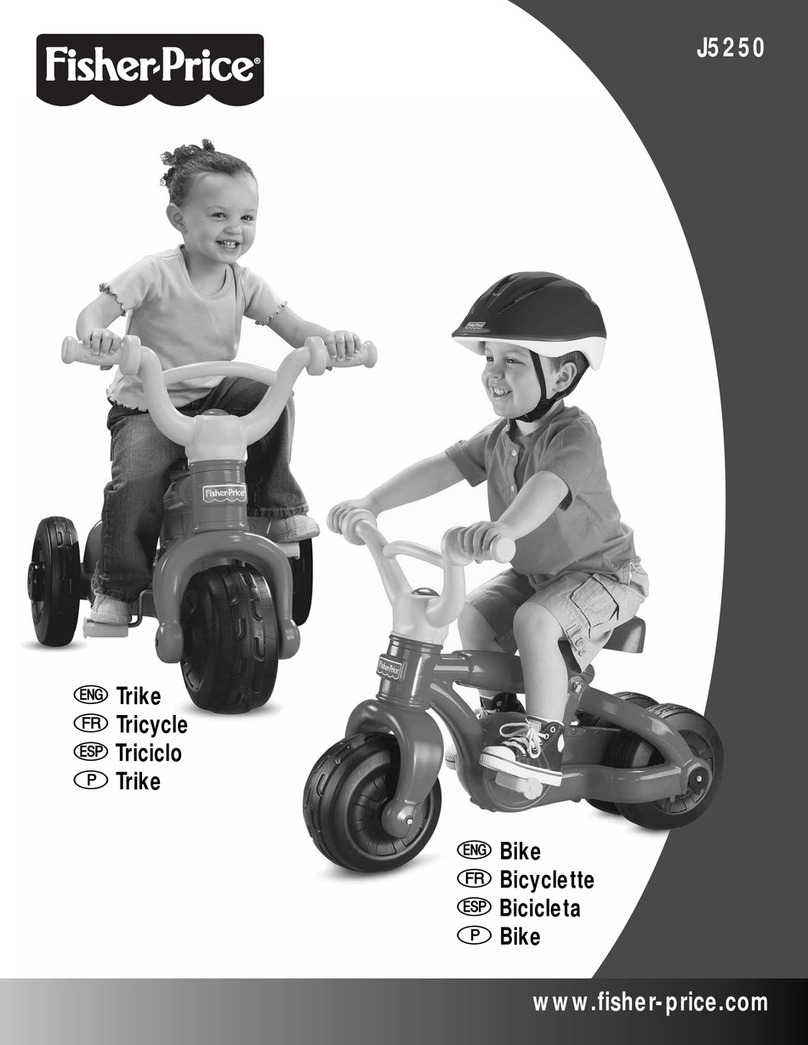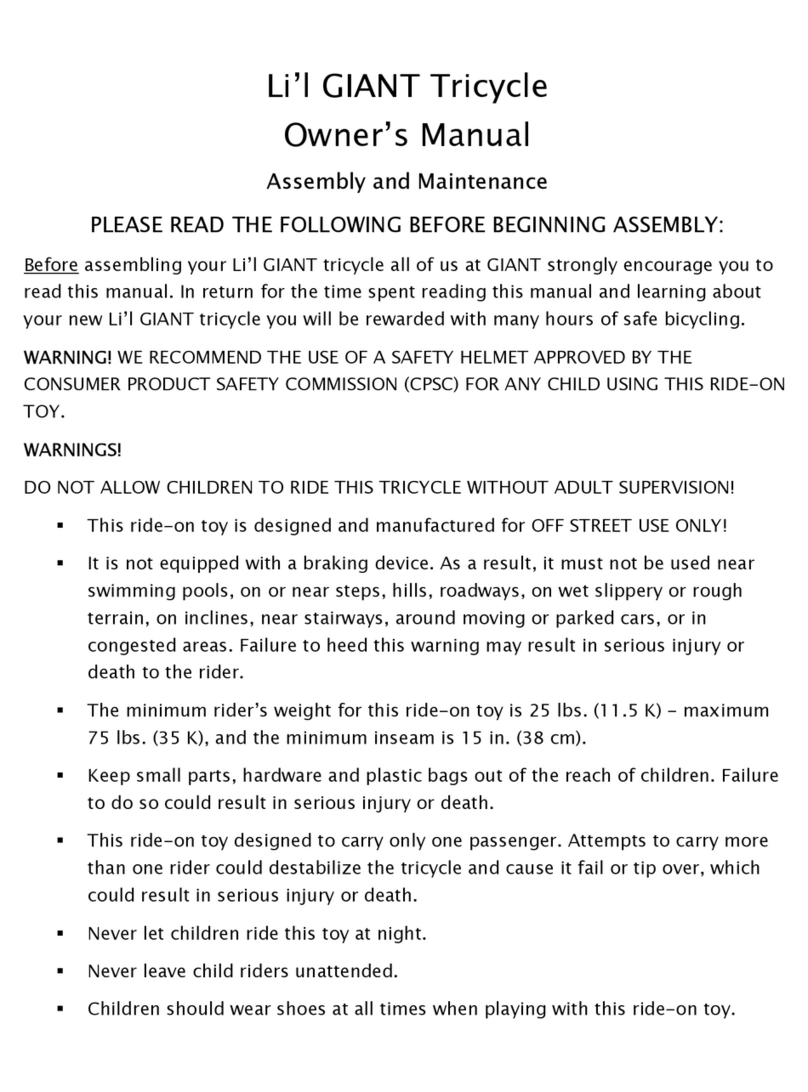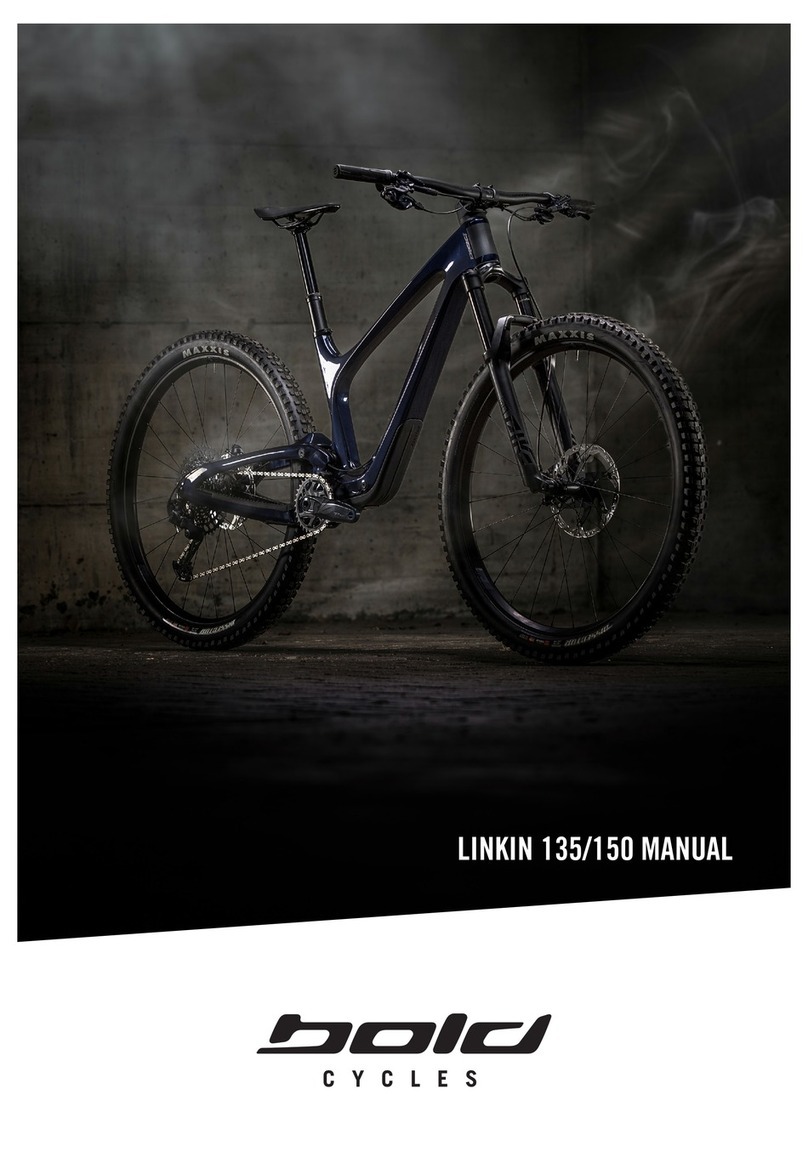Nikitin E-Cruiser User manual

USER MANUAL
E-Cruiser / W-Pace Urban
Table of Contents
GENERAL INSTRUCTIONS 2
ASSEMBLY 2
PRE-RIDE SAFETY CHECK 3
RIDING INSTRUCTIONS 3
RIDING 3
PARKING 3
CHARGING INSTRUCTIONS 4
SAFETY 4
RECHARGING WHILST CONNECTED TO THE BIKE 4
RECHARGING WHILST REMOVED FROM THE BICYCLE 4
BATTERY MAINTENANCE 5
MAINTENANCE 6
RIMS &TYRES 6
BRAKES 6
CHAIN &DERAILLEUR 7
FASTENINGS &LUBRICATION 7
CLEANING 7
If any questions arise, please contact a Nikitin representative.

2
GENERAL INSTRUCTIONS
Our endeavor is to ensure that all Nikitin bicycles are functioning to the highest
possible standard. Therefore, please take the time to read and understand the manual
prior to your first ride. If any questions arise from the manual, please contact us for
further information.
As a new owner of the bicycle, it is imperative that you complete a pre-ride safety
check, carryout regular and proper maintenance, and reads the WA Cycling
Handbook (located on our website).
It is highly recommended that the initial ride is taken in a low or no traffic area, whilst
you learn to operate the power assistance from your electric bicycle.
ASSEMBLY
All Nikitin bikes are assembled and comprehensively checked prior to being
packaged within their carton. Each bicycle is folded in half with the handlebars and
seat post removed for safe transportation. It is recommended that two individuals
unpack the bicycles to avoid injury or damage to the bike. Below is a guideline on
assembly:
1) Carefully unpack the carton and remove all protective layers;
2) Unfold the bicycle and ensure that the central double lock is secured;
3) Remove the velcro sleeve (“Electric Bicycle”);
4) Ensure the double lock on the handlebar stem is secure;
5) Attach the handlebar to the stem, ensure it is perpendicular to the front wheel
and that the lever is securely fastened;
6) Reattach the Velcro sleeve (“Electric Bicycle”);
7) Insert the seat post at least to the minimum insertion level.
8) Ensure all items are removed from the box.
Special note: fasten the seat post and handlebars stem within the minimum and below
the maximum mark.

3
PRE-RIDE SAFETY CHECK
Check:
•The battery is fully charged and secured;
•The folding mechanism, handlebars, saddle, front and rear wheel fastenings
are secured;
•Tyres are inflated to the correct pressure;
•Front and rear brakes; and
•The chain has tension and has suitable lubrication.
RIDING INSTRUCTIONS
RIDING
1) Turn on the ignition switch to “ON” and press the power switch for the LCD
display;
2) Ensure that the power assistance level on the LCD display is set to either ‘1’
or ‘2’ (as a low level of assistance is adequate to commence cycling).
3) Ensure the kickstand is raised, start pedaling and the power assistance will
gradually begin to assist the rider. Once at your chosen speed, adjust the
power assistance to suit;
4) Alternatively, the use of the thumb throttle can assist the rider up to 6KPH
whilst pedaling;
5) The brakes are fitted with power cut-off, which means that when the brake
lever is activated the motor will automatically disengage.
Special note: It is highly recommended to pedal whilst starting or climbing steep hills.
This will assist the service life of the battery and motor.
PARKING
Ensure the bicycle has been parked on level ground. Turn the power assistance to 0,
switch off the LCD display and turn the ignition key to off.
Special note: It is highly recommended that the bicycle is not stored in direct sunlight,
as long-term, this may damage electrical components on the bike.

4
CHARGING INSTRUCTIONS
SAFETY
1) Our range of electric bikes are only designed to be charged by our supplied
battery chargers, either the Sans 2A or 3A charger.
2) Prior to re-charging ensure that the charging environment is suitable. A
suitable area would be an undercover, well-ventilated area.
3) If you notice any unusual smell or noise while charging, stop charging and
investigate the issue.
RECHARGING WHILST CONNECTED TO THE BIKE
1) Ensure that the bicycle is turned off and remove the ignition key.
To connect the charger
2) Firstly, connect the output socket from the battery charger to the socket on the
battery pack. Secondly, connect the input socket with the wall socket. Thirdly,
turn on the power for the wall socket. Finally, check that the charger light is
illuminated, initially the light should be green and then switch to red, which
means the battery is charging.
3) Once the battery is fully charged the red light will switch to green. The green
light is a trickle charge. Therefore, it is strongly advised that the battery pack
is not charged for in excess of 2 hours after the green light has illuminated, to
maximise the longevity of the battery pack.
To disconnect the charger
4) Firstly, turn off the power from the wall socket. Secondly, disconnect the
output socket from the battery charger to the socket on the battery pack.
Thirdly, disconnect the input socket from the wall socket. Finally, store the
charger in a dry area, ideally within a box such as the supplied box.
RECHARGING WHILST REMOVED FROM THE BICYCLE
1) Ensure that the bicycle is turned off.
To remove the battery pack
2) Firstly, unlock the battery pack with the ignition key. Release the lever under
the saddle, then rotate the saddle from the horizontal to vertical position. Lift
the battery pack vertically until the battery pack clears the saddle.

5
3) Special note: Do not touch the battery terminals on the bicycle or battery pack
with your hands or a material that conducts electricity.
To connect the charger
4) Firstly, connect the output socket from the battery charger to the socket on the
battery pack. Connect the input socket with the wall socket and check that the
charger light is illuminated. Initially the light should be green and then switch
to red, which means the battery is charging.
5) Once the battery is fully charged the red light will switch to green. The green
light is a trickle charge. Therefore, it is strongly advised that the battery pack
is not charged for in excess of 2 hours after the green light has illuminated, to
maximise the longevity of the battery pack.
To disconnect the charger
5) Firstly, turn off the power from the wall socket. Secondly, disconnect the
output socket from the battery charger to the socket on the battery pack.
Thirdly, disconnect the input socket from the wall socket. Finally, store the
charger in a dry area, ideally within a box such as the supplied box.
To re-attach the battery pack
6) Firstly, ensure that the saddle is in the vertical position. Secondly, lower the
battery pack via the guide bracket and lock the battery pack into place with the
ignition key.
Special note: Do not touch the battery terminals on the bicycle or battery pack
with your hands or a material that conducts electricity.
BATTERY MAINTENANCE
1) To maximise the longevity of the battery pack it is strongly recommended that
after each usage the battery be recharged to maximum capacity.
2) In the event that the bicycle has not been used for at least 4 weeks, it is
advised to recharge the battery pack to maximum capacity.
3) It is not recommended to ride the bicycle with low levels of battery capacity as
this has the potential to damage the battery cells.
Special note: Please read the manufactures manual (Sans) for an in-depth
understanding on how to use the San charger.

6
MAINTENANCE
To ensure that your bicycle operates safely and at peak performance, it is vital that the
bicycle receives a service at regular intervals. The recommended minimum
requirement for our range of bicycles is that a service is completed at least once every
12 months or more frequently for every day usage.
BASIC GUIDELINE TO BICYCLE MAINTENANCE
Attention: Before carrying out any sort of maintenance, please ensure that the bicycle
is turned off and the ignition key is removed.
RIMS & TYRES
It is vital that the rims and tyres are maintained to assist with brake performance,
stability and overall safety. The below items should be checked whilst maintenance is
completed:
•Remove dirt or grease from the rims;
•Check wheel alignment – adjust if out of line;
•Check the tension of each spoke and repair damaged spokes;
•Check the front and rear hubs are secured;
•Check the front wheel quick release is secured;
•Check the condition and tread depth of the tyres;
•Check the inflation of the tyres, as per the manufactures recommended
inflation; and
•Check that each tyre has a valve cap.
BRAKES
It is essential that the brakes be maintained to improve brake performance. The below
items should be checked whilst maintenance is completed:
•Remove dirt or grease from the calipers and brake pads;
•Check the condition of the discs and brake pads, changed if required;
•Check the tension of the disc bolts and caliber bolts; and
•Adjust brakes to ensure peak performance.
Special note: the above is only a brief summary, please service the brakes as per the
Tektro manual provided with the bicycle.

7
CHAIN & DERAILLEUR
It is vital that the chain and derailleur are maintained. The below items should be
checked whilst maintenance is completed:
•Remove dirt or grease from the chain and derailleur;
•Check the tension of the chain, adjust if required;
•Check the alignment of the gears; and
•Reapply a suitable lubrication to the chain and derailleur.
Special note: the above is only a brief summary, please ensure to read and service the
derailleur as per the rear derailleur manual provided with the bicycle.
FASTENINGS & LUBRICATION
•Ensure front forks, front and rear axles, cassette, chain and other rotation parts
are regularly lubricated;
•Ensure all fastenings are secured;
Special note: the electrical parts do not require any lubrication; please ensure such
parts are not opened, as this will void the electrical component warranty. If you
believe there is an issue with an electrical component, please contact a Nikitin
representative.
CLEANING
The Nikitin range of electric bicycles should be cleaned with a damp microfiber cloth
or sponge and dried with a dry microfiber cloth.
Special note: when cleaning the bicycle avoid using a hose and take extra care not to
wet electrical components.
This manual suits for next models
2
Table of contents

